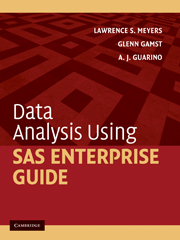Book contents
- Frontmatter
- Contents
- Preface
- Acknowledgments
- I Introducing SAS Enterprise Guide
- II Performing Analyses and Viewing Output
- III Manipulating Data
- IV Describing Data
- V Score Distribution Assumptions
- VI Correlation and Prediction
- 15 Bivariate Correlation: Pearson Product–Moment and Spearman Rho Correlations
- 16 Simple Linear Regression
- 17 Multiple Linear Regression
- 18 Simple Logistic Regression
- 19 Multiple Logistic Regression
- VII Comparing Means: The t Test
- VIII Comparing Means: ANOVA
- IX Nonparametric Procedures
- X Advanced ANOVA Techniques
- XI Analysis of Structure
- References
- Author Index
- Subject Index
17 - Multiple Linear Regression
Published online by Cambridge University Press: 05 June 2012
- Frontmatter
- Contents
- Preface
- Acknowledgments
- I Introducing SAS Enterprise Guide
- II Performing Analyses and Viewing Output
- III Manipulating Data
- IV Describing Data
- V Score Distribution Assumptions
- VI Correlation and Prediction
- 15 Bivariate Correlation: Pearson Product–Moment and Spearman Rho Correlations
- 16 Simple Linear Regression
- 17 Multiple Linear Regression
- 18 Simple Logistic Regression
- 19 Multiple Logistic Regression
- VII Comparing Means: The t Test
- VIII Comparing Means: ANOVA
- IX Nonparametric Procedures
- X Advanced ANOVA Techniques
- XI Analysis of Structure
- References
- Author Index
- Subject Index
Summary
Overview
Multiple linear regression is a direct extension of simple linear regression. We still use a straight line (linear) function based on ordinary least squares to predict a dependent variable. The only difference here is that multiple (more than one) quantitative or dichotomously coded predictors are used. It is common practice to generate the model (solution) by entering all the variables in a single step; this is sometimes called the standard or simultaneous method. However, other methods that call for entering (or entering and then removing) the variables in stages or steps can be used as well; SAS Enterprise Guide provides several on a drop-down menu that offer a range of method choices. We will focus here on the standard method.
Numerical example
We will use an extension of the example presented in Chapter 16 in which we wished to predict the number of hours that students watched television over 10 weekdays. In addition to grade point average (gpa in the data set) that we used as a variable in Chapters 15 and 16, we will also use the number of pages submitted by the students when they completed their reports (rep_size in the data set), the number of hours the children were in childcare during that 10-day weekday period (childcare hrs in the data set), and the number of hours per week the children used the Internet to interact with the Web site established by the school (internet hrs in the data set) to access school-related assignment and instructor materials.
- Type
- Chapter
- Information
- Data Analysis Using SAS Enterprise Guide , pp. 170 - 176Publisher: Cambridge University PressPrint publication year: 2009



